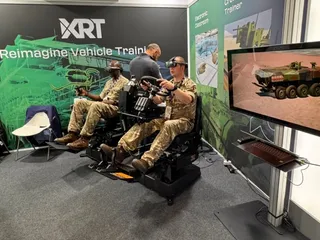Life Cycle Management Perspectives
Contact Our Team
For more information about how Halldale can add value to your marketing and promotional campaigns or to discuss event exhibitor and sponsorship opportunities, contact our team to find out more
The Americas -
holly.foster@halldale.com
Rest of World -
jeremy@halldale.com
HTE correspondent Marty Kauchak provides the second in a series of insights from simulation & training industry insiders and a simulation center, on the challenges and opportunities in managing the life cycles of their learning technologies and systems.
Stephanie Alwais, the chief operating officer at Vascular Simulations, LLC, summarized the importance of life cycle management in today’s learning environment, “Life cycle management is a crucial component of any form of simulation training, especially in the healthcare industry.” The Stony Brook, New York-based executive noted that in order to effectively “mimic” a given condition, the user needs to be informed as to the properties and state of the simulator they are using. “For example, if one of our silicone vessels bursts during a procedure, the trainee needs to know if that was due to the fact that the vessel was nearing the end of its life or if it was designed that way or if it was a mistake that occurred during the procedure,” she added.
The industry expert further emphasized when engineering a new medical simulation tool, life cycle management should be taken into account. “Vascular Simulations’ vascular models are manufactured using silicone to mimic the feel of native vessels, but also to be durable for true simulation use over time. Customers are concerned about what costs, both financial and time, will be incurred over the life of the simulator. This helps to plan projects, both current and future and understand what expenses to expect after a few years of continued use.”
Alwais spoke from the perspective of Vascular Simulations having sold its products to medical device companies, simulation labs, teaching hospitals and engineering teaching labs. Medical device companies use the company’s silicone vessels and replicator system for research and development of new devices as well as for technical sales and training. “Teaching hospitals and simulation labs use our products to mimic specific conditions for training purposes. Engineering teaching labs use our products to measure flow and pressure at various points of our system, in an effort to teach engineering students about fluid dynamics,” the company executive added.
Company Life Cycle Strategies
S&T companies are not so subtly strengthening their life cycle processes.
In one instance, the silicone vessels produced by Vascular Simulations will reportedly last, even with repeated use, for years. For medical device companies, especially research and development departments, their main concern is with the ability to deploy a device into Vascular Simulations’ vessels, easily retrieve it and deploy it again, with little to no damage to the vessel. Alwais pointed out, “Our replicator system is a complex electromechanical system that does occasionally require maintenance. If properly shipped and handled correctly, it requires little maintenance over the course of its life. Vascular Simulations offers a year-long warranty that covers all parts and service performed within the first year.”
These and other life cycle programs are evolving with an eye on customer expectations and requirements.
Customer Expectations and Requirements
Vascular Simulations’ Alwais noted her customers are concerned about repeated usability of silicone vessels over time. She continued, “For our replicator system, they are also concerned with repairing damaged parts and minorly concerned with training on how to use the replicator. Another concern is the number of uses they can get out of a gallon of our blood mimicking fluid, which is directly dependent on the amount of contrast that is added to the solution when using it under fluoroscopy.”
Pedro Pinto, the CEO at Body Interact Inc., looked at his customers' recent and emerging, life cycle support concerns and requirements from another perspective. The industry executive noted the high-performance expectation of a medicine practitioner is dependent upon the continual learning, professional accountability, independent and interdependent decision-making, and creative problem-solving abilities. “Sophisticated practice-based and performance-oriented learning programs that deliver improved patient outcomes will therefore be increasingly required, if not demanded. In our perspective, it is clear that competence is acquired primarily through experiential learning.” From that perspective, interactive, life-like simulation technology, particularly based on interactive 3-D realistic learning environments, enables an effective shift from a medical education curriculum focused mainly on structure and process
to one concerned mainly with the development and measurement of competency-based performance.”
Pinto provided his insights based on his Portugal-based company’s expanding product line – which this author most recently viewed at 2016 IMSH.
The flagship product Body Interact™ is reportedly being recognized as a leading 3-D digital medical simulator for decision-making education, enhancing a hands-on pragmatic clinical reasoning experience. According to Pinto, it offers students and professionals alike, an interactive life-like patient-based experience using a powerful physiological algorithm that mimics real-time patient health conditions, provides realistic feedback, and it is able to compile and assess the users performance. He continued, “It is also adaptable across dozens of pre-configured and totally dynamic clinical scenarios including cardiology, endocrinology, neurology, respiratory, infectious diseases, trauma and in couple of month pregnancy and pediatrics as well.”
As this article was being prepared for publication, Body Interact™ was being adopted in several educational contexts: for schools of medicine and nursing, simulation centers, professional clinical skills certification (doctors, nurses and paramedics) and e-learning simulation-based courses (cardiology, stroke, internal medicine and cancer management). “Our product supports currently these languages: English, Spanish, German, Italian, French, Portuguese, Mandarin and Japanese,” he added.
Placing Manage in Management
According to Janet Willhaus, PhD, RN, CHSE , the facilitator of Simulation Research for the Boise State University Health Science Simulation Center, that center’s staff truly manages its materiel to achieve efficient and effective operations.
“Equipment is an important component to smooth operation, but even more important is the use of a checklist to ensure that all equipment is functioning and operational prior to any simulation activities,” Willhaus said. “Our operations specialists ensure that equipment is maintained and kept functioning for longer life. Keeping track of the number of hours a piece of equipment is used and how much overall repairs cost for each item is another way to track cost and determine when it is time to rotate out a piece of equipment. Additionally, we have found that students prefer to work with Standardized Patients which are in the long run less expensive for us than manikin equipment,” the community expert added.
Asked to provide the center staff’s current life cycle topic of interest, Willhaus responded the system which requires the most attention is the audiovisual and recording system. “This is a centralized system which requires support from the vendor. It is a complicated system with many features that we do not use in our center. As a result we are considering working with a local vendor to replace this complicated system with one that better meets our needs and will be simpler to operate and maintain,” the center official further explained.
Willhaus also conveyed an opportunity for the simulation and training industry to better meets its customers’ needs. In a message that should resonate with other end users, she said, “Simple is often better. For example, we do not use the IV system with our manikins and have a self-made bypass set up. The use of IV fluids in the manikins shortens their usable life.”
Looking at their program out years, service and cost are important factors in the center’s decision to purchase new products. “Equipment which can be easily maintained on site is another consideration,” Wilhaus concluded.
On the Near-Term Horizon
Pinto provided a compelling reason to remain attentive to and monitor customer requirements – based on his assessment the demand for learning technologies will remain strong well beyond this decade. The executive pointed out that for hospitals seeking more efficient training methods, simulation-based training is becoming much more attainable as newer technologies make it more cost-effective and easier to manage than even a few years ago. “Today, hospitals are finding that simulation-based training offers a powerful tool to standardize training, meet evidence-based guidelines, and target specific quality goals. It is for these reasons that simulation-based training is poised to save the industry billions of dollars,” he emphasized .
As a result, educational tools are needed to allow hospitals and universities to effectively train healthcare professional during their career, based on real and scientific context. Looking at his portfolio, Pinto pointed out as a multi-platform solution, Body Interact™ creates a realistic patient responsive simulation designed to introduce in clinical cases random components to better simulate reality, stimulate logic, thinking and decision-making, with cost-effectiveness and fast scalability.
Specifically in 2016 and beyond, Body Interact™ is viewed with the potential to disrupt the medical education market through simulation of specific clinical cases adaptable to different medical areas. “Besides the emergency context, in 2016 we have launched the Pre-Hospital Care and Chronic Care context as well, providing a complete training setting for the patient journey.
We also shall launch new training areas like pregnancy and pediatrics together the development of a tool to enable a structured OSCE [Objective Structured Clinical Examinations] with BodyInteract™ ,” he concluded.


